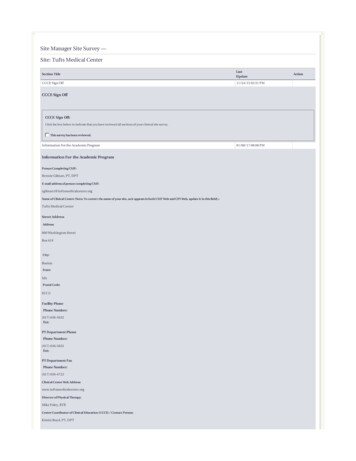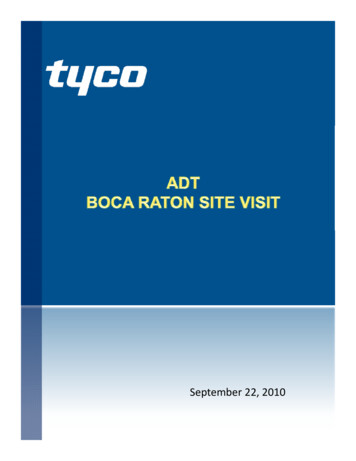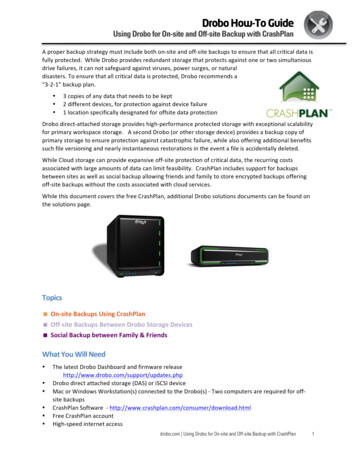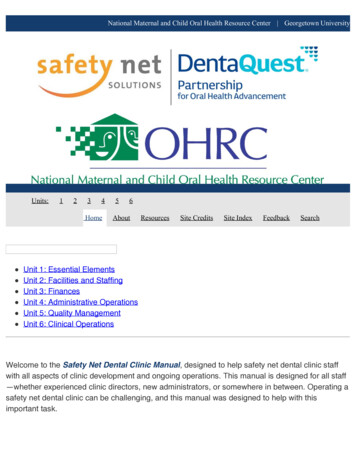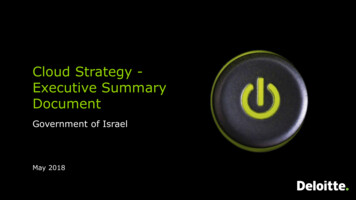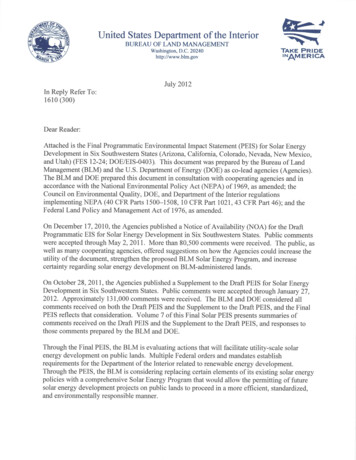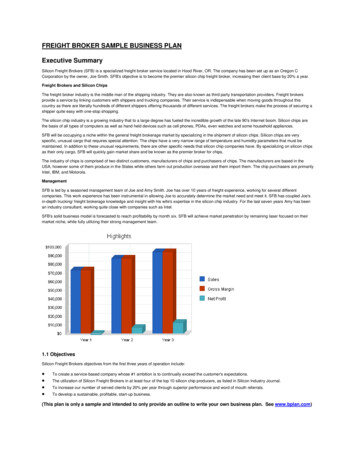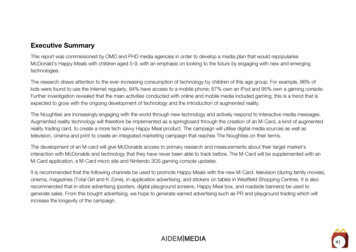
Transcription
Commission on Behavioral ApplicationsCambridge Center for Behavioral StudiesJuly 26, 2005To: CCBS Commission on Behavioral ApplicationsFrom: Bill Hopkins and Dwight HarshbargerExecutive summary of site visit observations and recommendationsOn June 22 - 24, 2005, we visited the Halliburton Gulf of Mexico Operations forpurposes of a behavioral safety program site-review for CCBS Accreditation.A complete report of our site visit observations follows this summary.Recommendation to the CCBS Commission on Behavioral ApplicationsThe accreditors recommend to the Cambridge Center’s Commission on BehavioralApplications that Halliburton’s Gulf of Mexico Operations integrated safetyprogram be accredited as an exemplary safety program with a Principles ofBehavior Based Safety program as a core component; that this accreditation be fora period of three years.This recommendation is conditional based on:1. Completion of necessary revisions of the application,2. Cooperation in further analysis of safety data,3. Agreement to update safety performance data on the CCBS web site every 6months.The program observations and recommendations of the site visitors are available in theExecutive Summary, above, and in Appendix A at the end of this report.Recommendations.Copyright 2006 Cambridge Center for Behavioral StudiesCBA Halliburton Gulf of Mexico Site Visit Report and Recommendations1
General Observations1. The PBBS program is effectively integrated with Health-Safety-Environmentinitiatives; the programs function seamlessly as a single program.Injury incident rates are well below the performance of other Halliburton regions,and well below industry comparisons provided by the Bureau of Labor Statistics.GOM incident rates have been sustained at low levels for several years and haveprogressively improved over time.2. The BBP programs and processes as described in the application, sampled by sitereviewers in work sites, occur as described in the application. They operate withconsistency and in accordance with sound behavioral practices.3. Safety data entered in the data base are valid. The injury investigation methods appearto be thorough. A number of built in-security procedures prevent anyone fromtampering with the data. The data CCBS reviewed are aggregate data based onmultiple locations, only some of which were visited and observed. Individual sitesmay vary in their safety performance.5. Employees engage in the BBP GATOR (Gulf Coast Action Team Observing Risk)program in positive and appreciative ways.6. The program leadership is energetic and effective – There is an effective and fully functioning Steering Committee. The Leadership Team, comprised of senior managers, actively promotesand supports BBP. The program facilitator is passionate about the program and appropriatelyfocused.Recommendations for Halliburton’s Gulf of Mexico Operations and GATOR1. GATOR observers, observations Consider steps to increase the number of trained observers; for example,going through observation training could be a company requirement,though participation in the program as an observer could remain, as it nowis, voluntary. Develop and implement methods to document, post and reinforcedesirable rates of observations by work groups and individual observers. Monitor exactly which employees are observed. Shape and reinforce the behavior of making observations, givingfeedback.Copyright 2006 Cambridge Center for Behavioral StudiesCBA Halliburton Gulf of Mexico Site Visit Report and Recommendations2
Examine the distribution of observers across work groups; make sure thatobservers are proportionally represented in all work groups anddepartments.Give attention to local sites and PSLs re contact rates - measure, givefeedback, and reinforce progress in the achievement of incremental stepstowards contact rate goals for each site, each PSL.2. Gator coaches Develop and implement methods to document, post and reinforcedesirable rates of coaching among qualified coaches. Shape and reinforcethe coaching participation and behavior.3. Getting below zero Give additional importance and reinforcement to programs now in place,such as “Beyond the Red Zone”, that focus on recording near misses andsimilar hazard measurement as ways to deepen effective safety practices. As part of this effort, continue and increase GATOR’s attention toapplication of behavioral safety practices in employees’ homes andfamilies.4. WIN – work design and equipment improvements Increase the reinforcement and recognition for work groups whosuccessfully observe and implement changes in work design andequipment.5. Observations and coaching in drilling operations, off-shore and on-shore Off-shore and on-shore drilling customers’ work and time utilizationrequirements place constraints on coaching opportunities and to a lesserdegree on making observations. Consider the development of alternative observation and coachingmethods for off-shore and on-shore drilling operations. For example, doobservations during the performance of jobs in ways that permitintegration with brief periods of observations. Coaching might be delayed for off-shore teams until the return to landbased work, or for on-shore drill teams after they return to their PSL homesites, within a specified period of time. For example, within 24 hours afterthe observation and / or arrival on shore or at the PSL home site. Work to install at least one observer and one coach in every off-shore andon-shore drilling team.6. Continue efforts to expand ergonomics analyses of job demands and performance.7. Assess ways to extend BBP and the integrated safety program into other regionaloperations of Halliburton.Copyright 2006 Cambridge Center for Behavioral StudiesCBA Halliburton Gulf of Mexico Site Visit Report and Recommendations3
Compare estimates of the total (direct and indirect) costs of incidents andinjuries across regions; develop the business case for the value of GOMsafety effectiveness in both human and financial terms.Offer GOM-based training opportunities to other parts of the company.Assess the possibility of intra-company streaming of BBP training andprogram development.Publicize the achievement of accreditation standards; challenge otherregions to work equally safely and meet these standards.Site Visit ReportHalliburton Gulf of Mexico NWA OperationsCommission on Behavioral ApplicationsCambridge Center for Behavioral StudiesJuly 26, 2005To: CCBS Commission on Behavioral ApplicationsFrom: Bill Hopkins and Dwight HarshbargerRecommendation to the CCBS Commission on Behavioral ApplicationsThe accreditors recommend to the Cambridge Center’s Commission on BehavioralApplications that Halliburton’s Gulf of Mexico Operations integrated safetyprogram be accredited as an exemplary safety program with a Principles ofBehavior Based Safety program as a core component; that this accreditation be fora period of three years.This recommendation is conditional based on:4. Completion of necessary revisions of the application,5. Cooperation in further analysis of safety data,6. Agreement to update safety performance data on the CCBS web site every 6months.The program observations and recommendations of the site visitors are available in theExecutive Summary, above, and in Appendix A at the end of this report.Recommendations.Copyright 2006 Cambridge Center for Behavioral StudiesCBA Halliburton Gulf of Mexico Site Visit Report and Recommendations4
Application ReviewThe Accreditors reviewed and approved the application of Halliburton – Gulf of MexicoGATOR – Gult Coast – Action – Team – Observing Risk. The application followed theCCBS on-line standards outlined in PBBS Application Kit 1.0 and PBBS AccreditationStandards 1.0.Site VisitOn June 22 - 24, 2005, Dr. Bill Hopkins and Dr. Dwight Harshbarger visited theHalliburton Gulf of Mexico Operations for purposes of a behavioral safety program sitereview for CCBS Accreditation.Halliburton Identifying Information Name of the Organization – Halliburton Gulf of Mexico NWA – GATOR BBSLocation of Corporate Office – 110 Capital Drive – Lafayette Louisiana (Gulf ofMexico Operations)Houston Texas – Global Headquarters for Halliburton Energy Services Division.Name of company representative in charge of the application. Chris SchaferPhone Numbers of the representative – Office – 337.266.8265 Cell – 37.849.6014Address of the Representative – 110 Capital Drive – Lafayette, Louisiana 70508E-Mail address of the representative – chris.schafer@halliburton.comHalliburton is a world-wide company employing approximately 90,000 employeesproviding services to most every country in the world. Halliburton Company has twomain sub-companies, Halliburton Energy Services (HES) and Kellogg, Brown and Root(KBR). KBR is primarily a heavy construction company and HES provides services tothe oil and gas industry.HES is organized by Natural Work Environments (NWA). The Gulf of Mexico (GOM)NWA is one of 6 NWAs in the USA. An NWA is composed of many product servicelines (PSL) to the oil and gas industry, but all of the PSLs report to the NWA leadership.The Health, Safety and Environment (HSE) department in the Gulf of Mexico covers allof the GOM NWAs- every PSL follows the same HSE policies and reports to the HSEOperations Manager in the Gulf.Gulf of Mexico NWAThe Gulf of Mexico NWA is Halliburton’s largest NWA with 2182 employees and 43facilities. Geographically the area is the smallest NWAk covering south Louisiana andeastern coastal Texas. GOM provides oil and gas services to customers in the Gulf ofMexico waters, inland waters (marches, swamps) and land oil and gas wells. GOM hasapproximately 750 vehicles and a fleet of marine vessels to aid in our service delivery.Copyright 2006 Cambridge Center for Behavioral StudiesCBA Halliburton Gulf of Mexico Site Visit Report and Recommendations5
The Gulf of Mexico operations are the most diverse operations that Halliburton has worldwide, and a proving ground for new technology and procedures for world wideoperations.In the Gulf of Mexico GATOR (Gulf Action Team Observing Risk) is involved only inthe Energy Services Division. All numbers provided in employee headcounts, facilities,and locations are for the Energy Services Division only.Product Service Lines (PSLs)Fluids Division Baroid- Baroid PSL provides drilling fluid services to the oil and gas field. Thedrilling fluid or completion fluid keeps the oil well under control until the well iscompleted. Baroid has 396 employeesCement- Cement PSL provides cementing services to the oil and gas industry.Once a well is drilled, a customer runs steel conduit to produce the well, the steelconduit is cemented in place by our Cementing PSL. Cement PSL has 300employees. The company began in cementing.Summary of Fluids Division- Baroid and Cement are the largest PSL’s in theGOM Operations. Most of their 25 facilities are coastal facilities varying from 1to 25 employees.Completions and Reservoir Optimization Division – CRO –Completion Productsand Services (CPS) Once a well has been cemented, the customer needs a completionplan to optimize oil and gas production. This PSL designs the completion plan and thenimplements the completion plan for the customer. CPS has 185 employees.Tools-Testing & Tubing Conveyed Perforating- TTTCP provides tools that canbe attached to a drill string to provide a service to an oil or gas well. TTTCP alsoexplosively perforates an oil or gas well once it has been cased and cemented tobring the well on line. TTTCP employees 127 employees.CRO Division Summary- The second largest PSL in the GOM; services involvecomplex technologies and well-trained location service providers.Sperry Sun- does evaluation and direction surveying while drilling an oil well. SperrySuns tools are attached to the drill pipe and while drilling capture instantaneousinformation about the formation that a customer can utilize to make decisions. SperrySun Sperry Sun has 297 employees. Sperry Sun was acquired in the late 1990’s throughthe acquisition of Dresser Industries.Production Enhancement Division- (PE)- enhances existing producing wells. PE iscomposed of four distinct separate services.FA/SC – Frac Acid and Sand Control – Provides services to fracture a formationto optimize production, and controls the sand that can be produced from aCopyright 2006 Cambridge Center for Behavioral StudiesCBA Halliburton Gulf of Mexico Site Visit Report and Recommendations6
deteriorating formation. FA/SC has 108 employees based at Port Fourchon andNew Iberia.CT – Coil Tubing – Uses rigid steel tubing that is rolled on a drum to deliverservices in wells that are highly deviated. Coiled Tubing has 55 employees.N2 – Nitrogen – utilizing nitrogen to stimulate wells – Nitrogen has 20employees.HWO Hydraulic Work Over –provide maintenance to existing wells. HWO has20 employees.Production Enhancement Division Overview - Together the 4 sub-PSL providesome of the most physically demanding jobs in the oil field. There are over 200employees.Logging and Perforating – Logging provides Seismic, Reservoir Evaluation,Perforating of the oil well to make it produce, and post well completion services tocustomers. L&P has 153 employees.Integrated Solutions- (IS-HDS-Landmark Digital Services) This PSL provides on siteconsulting services for field operations at a customers request. IS also does welldecommissioning HDS (Halliburton Decommissioning Services)- capping wells that nolonger produce. IS has 49 employees. IS is not presented graphically because they have5 years of 0 Total Recordable Incident Rate.Miscellaneous Support- This includes our Maintenance department, our procurementand materials department, and a pool of engineers that are utilized by PSL’s,Maintenance has 79 employees distributed across facilities.Security DBS – (SDBS) – Builds the drilling bits that drill an oil well; 19 employees.SDBS is not presented graphically because they have 5 years of
Executive summary of site visit observations and recommendations On June 22 - 24, 2005, we visited the Halliburton Gulf of Mexico Operations for purposes of a behavioral safety program site-review for CCBS Accreditation. A complete report of our site visit observations follows this summary.File Size: 818KBPage Count: 54
